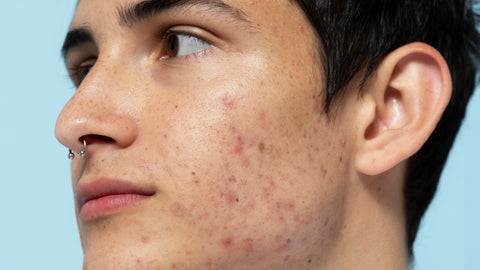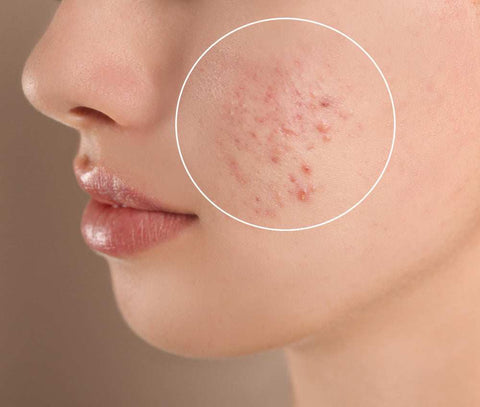How Long Does Skin Purging Last?


Skin purging is a reaction that may occur when individuals begin a new skincare regimen, particularly those containing active ingredients such as retinoids, alpha hydroxy acids (AHAs), beta hydroxy acids (BHAs), or vitamin C. Dr. Emily Roberts, a dermatologist, defines skin purging as "a temporary increase in acne and skin inflammation due to the acceleration of skin cell turnover rates." This process is essential for revealing fresher, healthier skin layers but can lead to temporary discomfort.
Understanding the distinction between skin purging and breakouts is crucial. Breakouts typically occur due to clogged pores, bacteria, or hormonal changes and are not necessarily related to the acceleration of skin cell turnover. Skin purging, however, is a direct response to an active ingredient in skincare products, which eventually improves the skin's texture and appearance.
The duration of skin purging is significant as it affects individual decisions on whether to continue or cease using a new skincare product. Patience and understanding are vital during this period to ensure that the skin receives the full benefits of the treatment. For those beginning their retinoid journey, a gentler introduction such as the REN Clean Skincare Bio Retinoid Youth Serum may help balance effectiveness with reduced irritation.

Skin purging occurs due to the increased rate of skin cell turnover, leading to the rapid emergence of pimples, blackheads, or pustules on the skin's surface. Dr. Linda Greene, an expert in dermatological studies, states that "skin purging is essentially the skin's adjustment period to new products, allowing new, healthier skin cells to surface." Causes of skin purging include the introduction of active ingredients in skincare routines that prompt this increased cellular turnover.
Skincare products containing ingredients such as retinoids, AHAs, BHAs, and vitamin C are known to trigger skin purging. According to a study published in the Journal of Dermatological Science, retinoids significantly increase skin cell turnover rate, making them a common cause of skin purging. For example, Sol de Janeiro’s Bom Dia Brightening AHA Body Cream incorporates fruit-derived acids and niacinamide to smooth texture and brighten dull areas—perfect for those experiencing body purging on the chest, back, or shoulders.
The skin's renewal cycle, typically lasting about 28 days, is pivotal to understanding skin purging. During this cycle, old skin cells are shed, and new cells are brought to the surface. When active ingredients accelerate this process, it can result in temporary skin purging.
The general timeframe for skin purging can vary, typically lasting anywhere from four to six weeks. Dr. Roberts explains, "While the duration of skin purging varies among individuals, most will experience a clearing of the skin within four to six weeks as the skin adjusts to new products."
Several factors can affect the duration of skin purging, including the type of skincare product used, individual skin type, and how frequently the product is applied. It is essential to consider these factors when evaluating the progress and impact of skincare treatments.
A week-by-week breakdown can help individuals understand what to expect during the purging process. Initially, one might notice an increase in blemishes. By the second or third week, these should start to decrease as the skin begins to adapt to the new products. By the fourth to sixth week, significant improvements in skin texture and clarity are typically observed.
Identifying whether one is experiencing skin purging or breakouts is crucial. Skin purging typically occurs in areas where the skin already had clogged pores, whereas breakouts can occur randomly and are not necessarily tied to the use of new skincare products.
Dr. Greene suggests, "To differentiate between purging and regular breakouts, observe the areas where the blemishes occur and consider whether you've recently started a new skincare treatment containing active ingredients." This insight can help determine the appropriate course of action. To support your skin’s barrier during this process, a hydrating formula like the Flexitol 10% Urea Cream can gently exfoliate and lock in moisture without clogging pores.
Consultation with a dermatologist is recommended if the skin does not improve after six weeks or if the skin reaction is severe. This could indicate that the issue is not purging but rather an adverse reaction to the product. Maintaining clear skin requires more than just treatment—it needs consistent care. Welzo’s complete skin care collection features products that support barrier repair, hydration, and long-term skin health beyond acne.
Managing the discomfort and appearance during the purging phase requires patience and gentle care. Dr. Emily Roberts recommends, "Maintaining a simplified skincare routine to avoid further irritation." During this period, it is essential to keep the skin hydrated and to avoid picking or squeezing blemishes, which can lead to scarring.
Skincare practices beneficial during the purging process include using non-comedogenic moisturisers to maintain skin hydration and applying sunscreen daily to protect the skin from UV damage. Products containing soothing ingredients such as aloe vera or niacinamide can help reduce inflammation and redness. Topically calming options like the Source Naturals MSM Cream may assist in softening and comforting areas prone to inflammation or tightness.
Regarding the continuation or cessation of the use of a product causing purging, Dr. Linda Greene advises, "If skin purging does not improve after six weeks or if severe irritation occurs, it is advisable to stop using the product and consult a dermatologist." However, if the skin is gradually improving, it may be beneficial to continue using the product, as this indicates that the purging process is leading to healthier skin.
To prevent severe purging, introduce new products containing active ingredients gradually into your skincare routine. Dr. Roberts suggests, "Start by applying the product once or twice a week and gradually increase usage as your skin adapts." This method allows the skin to adjust to the new product without overwhelming it, reducing the severity of the purging process.
Maintaining clear and healthy skin after the purging period involves adhering to a consistent skincare routine tailored to your skin type. It is crucial to continue using products that promote skin renewal and hydration while avoiding those that can clog pores or cause irritation.
The importance of a consistent skincare routine cannot be overstated. Regular cleansing, moisturising, and application of sunscreen protect the skin from external factors and maintain its health and clarity. Dr. Greene emphasises, "A consistent skincare routine is essential for sustaining the benefits achieved through the purging process and for preventing future skin issues."
For those exploring broader solutions for breakouts, Welzo offers a wide range of effective options in their curated medication for acne collection. It includes both prescription and over-the-counter treatments tailored to various skin types and severities.
Skin purging typically manifests as a sudden flare-up of blackheads, whiteheads, or small red bumps. These breakouts usually appear in clusters on areas of the face where you are already prone to acne, and can seem to emerge all at once. Dr. Emily Roberts notes, "Skin purging often results in lesions that heal more quickly than typical breakouts. They're a response to increased cell turnover and tend to surface around the same areas where one might experience congestion."
The skin may also appear slightly red or inflamed due to the increased activity beneath the surface. Unlike traditional breakouts that can form randomly on the skin, purging often follows a pattern consistent with areas of previous congestion. This is a crucial distinguishing factor, as Dr. Linda Greene points out: "While purging, skin may look worse before it gets better, but these symptoms are generally a sign that the product is effective and the skin is expelling impurities."

Yes, the skin typically improves after the purging phase. This process, although initially distressing, is a sign that the skincare products are effectively stimulating new cell turnover. Once the purging phase is over, the skin often appears smoother, clearer, and more radiant than before. According to dermatological studies, after the completion of a purging phase, individuals may notice a significant reduction in acne lesions and a more even skin tone. Continue reading to learn What Type Of Acne Do I Have
Dr. Roberts explains, "After the skin has adjusted to new products and expelled the underlying impurities, one can expect a visible improvement in the skin's overall texture and appearance." It's important to note, however, that this outcome is contingent on the individual's skin type and the nature of the products being used.
While it's not possible to 'get rid of' skin purging outright, since it's a natural response to certain skincare products, there are ways to manage and alleviate the symptoms:
By following these guidelines and allowing the skin time to adapt, most people can effectively manage the symptoms of skin purging and eventually enjoy clearer, healthier skin.
Understanding and managing skin purging are crucial aspects of skincare, particularly when introducing new products containing active ingredients. While skin purging can be a challenging and uncomfortable process, it is often a temporary phase that leads to clearer and healthier skin. By distinguishing between purging and breakouts, managing discomfort, and following a consistent skincare routine, individuals can navigate the purging process more effectively.
Both managing the present condition and planning for future skin health are critical. Following the guidance of dermatologists and maintaining a tailored skincare regimen can mitigate the effects of purging and ensure the long-term health and appearance of the skin. Remember, patience and consistency are key in overcoming the challenges of skin purging and achieving a clear, radiant complexion.








Plus get the inside scoop on our latest content and updates in our monthly newsletter.